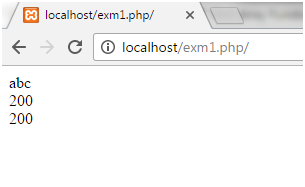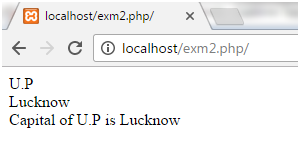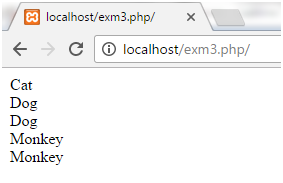PHP Tutorial
- PHP Tutorial
- Install PHP
- PHP Code
- PHP Echo and print
- PHP Variable
- PHP Variable Scope
- PHP $ and $$
- PHP Constants
- PHP Data Types
- PHP Operators
- PHP Comments
Control Statement
- PHP If else
- PHP Switch
- PHP For Loop
- PHP foreach loop
- PHP While Loop
- PHP Do While Loop
- PHP Break
- PHP Continue
PHP Functions
- PHP Functions
- Parameterized Function
- PHP Call By Value and reference
- PHP Default Arguments
- PHP Variable Arguments
- PHP Recursive Function
PHP Arrays
PHP Strings
PHP Math
PHP Form
PHP Include
State Management
PHP File
Upload Download
PHP OOPs Concepts
- OOPs Concepts
- OOPs Abstract Class
- OOPs Abstraction
- OOPs Access Specifiers
- OOPs Const Keyword
- OOPs Constructor and destructor
- Encapsulation
- Final Keyword
- OOPs Functions
- OOPs Inheritance
- OOPs Interface
- OOPs Overloading
- OOPs Type Hinting
PHP MySQLi
- MySQLi CONNECT
- MySQLi CREATE DB
- MySQLi CREATE Table
- MySQLi INSERT
- MySQLi UPDATE
- MySQLi DELETE
- MySQLi SELECT
- MySQLi Order by
PHP Topics
- Compound Types
- is_null() Function
- Special Types
- Inheritance Task
- Special Types
- MVC Architecture
- PHP vs. JavaScript
- PHP vs. HTML
- PHP vs. Node.js
- PHP vs Python
- PHP PDO
- Top 10 PHP frameworks
- phpMyAdmin
- Count All Array Elements
- Create Newline
- Get Current Page URL
PHP Mail
PHP allows you to upload single and multiple files through few lines of code only.
PHP file upload features allows you to upload binary and text files both. Moreover, you can have the full control over the file to be uploaded through PHP authentication and file operation functions.
PHP $_FILES
The PHP global $_FILES contains all the information of file. By the help of $_FILES global, we can get file name, file type, file size, temp file name and errors associated with file.
Here, we are assuming that file name is filename.
$_FILES[‘filename’][‘name’]
returns file name.
$_FILES[‘filename’][‘type’]
returns MIME type of the file.
$_FILES[‘filename’][‘size’]
returns size of the file (in bytes).
$_FILES[‘filename’][‘tmp_name’]
returns temporary file name of the file which was stored on the server.
$_FILES[‘filename’][‘error’]
returns error code associated with this file.
move_uploaded_file() function
The move_uploaded_file() function moves the uploaded file to a new location. The move_uploaded_file() function checks internally if the file is uploaded thorough the POST request. It moves the file if it is uploaded through the POST request.
Syntax
- bool move_uploaded_file ( string $filename , string $destination )
PHP File Upload Example
<form action="uploader.php" method="post" enctype="multipart/form-data">
Select File:
<input type="file" name="fileToUpload"/>
<input type="submit" value="Upload Image" name="submit"/>
</form>
<?php
$target_path = "e:/";
$target_path = $target_path.basename( $_FILES['fileToUpload']['name']);
if(move_uploaded_file($_FILES['fileToUpload']['tmp_name'], $target_path)) {
echo "File uploaded successfully!";
} else{
echo "Sorry, file not uploaded, please try again!";
}
?>



